It has fired the imagination of historians and archaeologists for centuries, but the mystery of the Hanging Gardens of Babylon may finally have been solved - with a surprising twist.
A leading Oxford-based historian says the fabled gardens, one of the Seven Wonders of the Ancient World, were not built in Hillah by King Nebuchadnezzar of Babylon. In fact they weren’t in Babylon at all.
Dr Stephanie Dalley, of Oxford University’s Oriental Institute, says the gardens were actually located 300 miles to the north in Nineveh, Babylon's rival, by the Assyrian ruler Sennacherib.

Glory of the ancients: A sixteenth century illustration of the Hanging Gardens of Babylon, which may not have been in Babylon at all. An Oxford historian claims they were actually built in the Assyrian city of Nineveh
There are four key components of Dr Dalley's theory, which will be outlined in a book released later this month.
As she studied historical descriptions of the gardens, she discovered that a nineteenth century bas-relief from Sennacherib’s palace in Nineveh showed trees growing on a roofed colonnade exactly as described by early accounts.
Secondly, Nineveh, the Assyrian capital, became known as 'New Babylon' when Assyria conquered Babylon in 689 BC - in fact, a number of places in the region were known by the name 'Babylon'.
She also discovered that the gates of Nineveh were renamed for those traditionally used for Babylon’s city gates after the successful invasion.
Thirdly, a geographical assessment found that the flat land surrounding Babylon would have made delivering water to the Hanging Gardens impossible.

Hillah in modern-day Iraq was thought to be the site of the Hanging Gardens. Dr Dalley's research shows it may actually have been in Nineveh, 300 miles away
She said: 'It’s taken many years to find the evidence to demonstrate that the gardens and associated system of aqueducts and canals were built by Sennacherib at Nineveh and not by Nebuchadnezzar in Babylon.
'For the first time it can be shown that the Hanging Garden really did exist.'
Incredibly, the revelations may mean that the Hanging Gardens were the first of the seven ‘wonders’ of the world to be described as such. Sennacherib referred to his palace gardens, as 'a wonder for all the peoples'.
ANCIENT WONDER: THE MYSTERY OF THE HANGING GARDENS OF BABYLON

Accounts state they were built in the ancient city-state of Babylon, near present-day Hillah, Babil province, in Iraq.
The gardens were attributed to the Neo-Babylonian king Nebuchadnezzar II, who ruled between 605 and 562 BC. He is reported to have constructed the gardens to please his wife Amytis of Media, who was said to pine for the plants of her homeland.
It is not known what happened to the gardens. Some theorise it was levelled by an earthquake.
The Hanging Gardens of Babylon are documented by ancient Greek and Roman writers, including Strabo, Diodorus Siculus, and Quintus Curtius Rufus.
Romano-Jewish historian Josephus once described it. He said: 'In this palace he (Nebuchadnezzar) erected very high walks, supported by stone pillars; and by planting what was called a pensile paradise, and replenishing it with all sorts of trees, he rendered the prospect an exact resemblance of a mountainous country.
'This he did to gratify his queen, because she had been brought up in Media, and was fond of a mountainous situation.'
However, no definitive archaeological evidence concerning their whereabouts has been found.
No comments:
Post a Comment